

Differentiation #saskedchat. ERIC – World’s largest digital library of education literature. Education Week American Education News Site of Record. Thinking Skills NOW (online only):Asking Good Questions. Kenneth E.
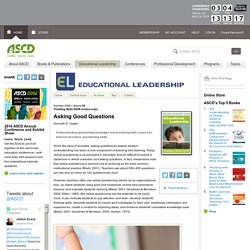
Vogler. Learning to ask "Good" Questions. If you want vibrant and lively discussion among your students, begin asking questions on the first day of class.

Facilitating a productive discussion requires asking questions which engage the interest and curiosity of the students. Ask open questions that cannot simply be answered “yes” or “no” or with a single “right” answer. Invite students to analyze, synthesize or evaluate course material. “Why?” And “How?” If the question is relevant to their lives in some way, it generates even more interest. When a student answers a question ask for clarification and examples if appropriate. Asking Questions to Improve Learning. When you prepare for class, office hours, and help sessions, compose specific questions that you will ask your students (or that you anticipate they will ask you).
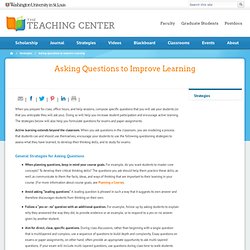
Doing so will help you increase student participation and encourage active learning. The strategies below will also help you formulate questions for exams and paper assignments. Active learning extends beyond the classroom. When you ask questions in the classroom, you are modeling a process that students can and should use themselves; encourage your students to use the following questioning strategies to assess what they have learned, to develop their thinking skills, and to study for exams. General Strategies for Asking Questions When planning questions, keep in mind your course goals. Responding Effectively Wait for students to think and formulate responses. Why Ask “Open” Questions? 1. What is the most important idea that was generated in today’s discussion? 2. Could you elaborate on that point? 3. 4. 5. 6. 7. 8. Love, Teach. The Importance Of Technology In Education Infographic. Educational Technology Infographics Technology in the field of education can be a powerful tool.
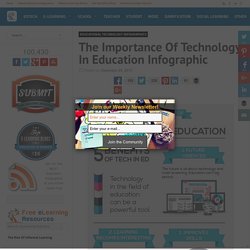
The Importance Of Technology In Education Infographic presents 5 benefits of technology in education: Using Minecraft in Education : Cross Curricular Ideas. Minecraft is an open sandbox game that allows players to construct their own world.
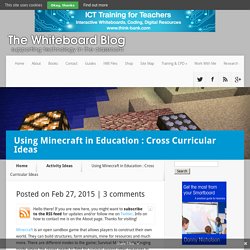
They can build structures, farm animals, mine for resources and much more. There are different modes to the game; Survival Mode is a challenging mode where the player needs to fight for survival against other creatures in the world, and Creative Mode provides unlimited resources to build and create without limitations. I’ve been investigating Creative Mode as it’s easier to build large structures quickly. Minecraft can be played individually, or as a multiplayer environment allowing children to cooperate to build and explore together. In Multiplayer mode they connect to a Minecraft Server on the internet or locally (running on a game hosted by one of the computers).
How students are using social media in education. Flipped learning is more than just having students do homework during the school day.
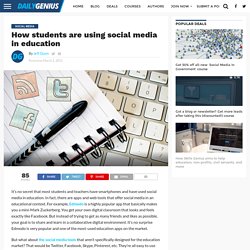
It’s more than just putting the onus on students to teach themselves. In fact, it’s neither of those things. Don’t be fooled by simple explanations of flipped classrooms that simplify a highly complex undertaking. Flipped learning is a hot trend in most stages of education right now – and for good reason. Twitter 101: 5-Step Guide for Social Media in Education. If you aren’t using Twitter, chances are that you’re reluctant to adopt new technology.
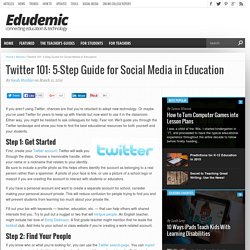
Or maybe you’ve used Twitter for years to keep up with friends but now want to use it in the classroom. Either way, you might be hesitant to ask colleagues for help. Fear not. 7 Ways Social Media Has a Role in Education #edtechbc. The Americas Society and Council of the Americas invited me to discuss the role of social media in education with experts and leaders dedicated to advancing and shaping the political, economic, social and cultural agendas of the Western Hemisphere.
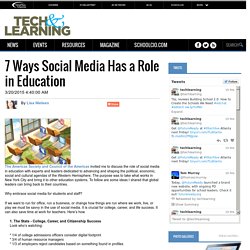
The purpose was to take what works in New York City and bring it to other education systems. To follow are some ideas I shared that global leaders can bring back to their countries. How To Teach Visual Thinking – 5 Strategies From Around The Web. The misconceptions about visual thinking are alarming.
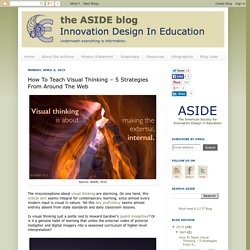
On one hand, this critical skill seems integral for contemporary learning, since almost every modern input is visual in nature. Yet this key proficiency seems almost entirely absent from state standards and daily classroom lessons. Is visual thinking just a polite nod to Howard Gardner's quaint modalities? Or is it a genuine habit of learning that unites the external codes of pictorial metaphor and digital imagery into a seasoned curriculum of higher-level interpretation?
Visual thinking is a close partner to graphicacy, which is a spectrum of analytical tools to decode and encode pictures. How To Teach Visual Thinking – 5 Strategies From Around The Web. Emerging Education Technologies #edtechbc. Creative Commons License Image Source With Competition Slowly Creeping in, How Goes it for the Behemoth of the Classroom Tablet Scene?
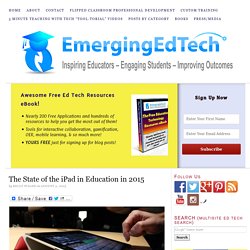
When Apple released the iPad in 2010, they took the world by storm, adding another jewel to their crown as the world’s leading provider of technology. The iPad suddenly made the until-then-overlooked tablet market something that mattered, and it kicked the mobile revolution into high gear. The introduction of the iPad also played no small role in Apple becoming the most valuable company in history by August of 2012.
Much as education has consistently favored the Mac over the PC, the sector jumped with gusto onto the iPad ‘bandwagon’. 5 Great Books On Using Minecraft In Education #edtechbc. September 7, 2015 Since its release in 2009, Minecraft has sold millions of copies worldwide revolutionizing thus the gaming industry and providing game players with an endless world of possibilities. As a sandbox construction game, Minecraft has successfully and distinctively set itself from the crowd by incorporating the ethos of 21st century learning that include: creativity, challenge, problem solving, and strategic thinking all of which are adeptly adapted to the player’s little gaming world.
ORC Document Library. Find Games By Skill - Math Games. Grades K-5.